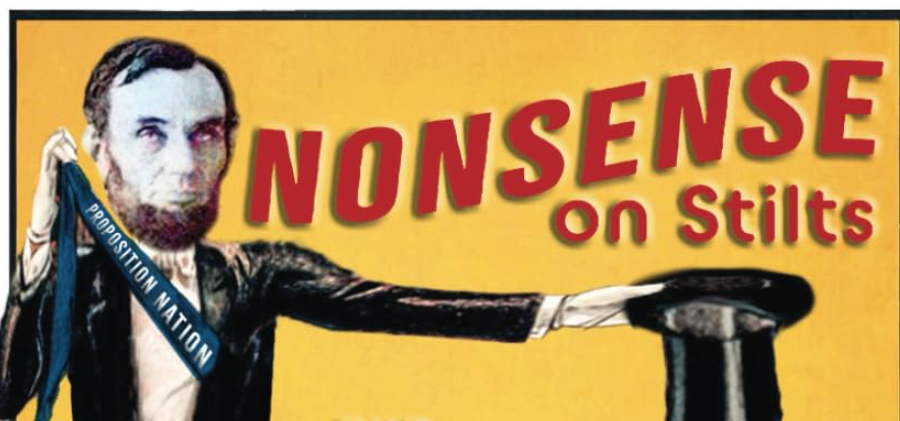
In a 1922 essay about Lincoln’s Gettysburg Address in his book Prejudices: Third Series H.L. Mencken asked, “Am I the first American to note the fundamental nonsensicality of the Gettysburg Address”? One example of the nonsense of Lincoln’s rhetoric as explained by Mencken is as follows:
“Think of the argument in it. Put it into the cold words of everyday. The doctrine is simply this: that the Union soldiers who died at Gettysburg sacrificed their lives to the cause of self-determination – that government of the people, by the people, for the people, should not perish from the earth. It is difficult to imagine anything more untrue. The Union soldiers in the battle actually fought against self-determination; it was the Confederates who fought for the right of their people to govern themselves” (emphasis added).
(“Nonsense on stilts,” by the way, was a phrase coined by nineteenth-century writer Jeremy Bentham to describe social contract theory. Today we would probably say “nonsense on steroids”).
Now along comes historian Paul C. Graham, a little over a century later, who has expanded upon Mencken’s essay in a short book entitled Nonsense on Stilts: The Gettysburg Address & Lincoln’s Imaginary Nation. It is easy to come to the conclusion after reading Graham’s book that it is hard to imagine a larger collection of falsehoods ever packed into a single political speech anywhere at any time than the Gettysburg Address. In essence, the Address was a radically false rendition of the American founding designed to fool the public into believing that the founding fathers did after all create a highly centralized, monopolistic superstate with virtually unlimited powers. That is why the totalitarian-minded “Pulitzer prize winner” (as Graham calls him) Gary Wills celebrated the Gettysburg Address as “a giant, if benign, swindle.”
Following Mencken’s example, Graham picks apart the Address by the old railroad industry trial lawyer/lobbyist, slick phrase by slick phrase. First of all, no “new nation” was brought forth “four score and seven years ago” as Lincoln absurdly asserted. The thirteen colonies seceded from the British empire and did not then create an empire of their own. “The colonists were not inventing something new; they were protecting something old, namely, self-government and their inherited rights as Englishmen which was being threatened by the English parliament . . .”
“Declaration of Independence” is actually slang for the actual title of the document, “The Unanimous Declaration of the Thirteen united States of America.” As in all the founding documents, “united States” is in the plural, signifying that the thirteen free and independent states were united in their desire to secede from the British empire. That is why, at the end of the Revolution, King George III signed a peace treaty with each individual state, not something called “the United States government.”
The first constitution, the Articles of Confederation, declared that each state “retained its sovereignty, freedom, and independence.” They retained, not gained, their sovereignty as “free and independent states,” as they are called in the Declaration. States rights, state sovereignty, the right of secession, and the states delegating a few powers to the central government as their agent were the ideas of the founders, not creating “a new nation.” There was no pledge of allegiance to “one nation, indivisible”; that was an invention of late nineteenth-century socialist and Lincoln worshipper Francis Bellamy.
Graham describes the second Constitution as an attempted and failed coup by the nationalists in American politics to destroy state sovereignty and consolidate all political power in the national capitol. At the constitutional convention Alexander Hamilton, for example, proposed a permanent president (aka a king) who would appoint all governors, with the central state having the right to veto any and all state legislation. His plan for a centralized dictatorship of course failed, but the nationalists, including Lincoln, would never give up.
Lincoln’s claim that America is a “nation” dedicated to the “proposition” that all men are created equal is a non-sequitur for several reasons, including the fact that it was never established as a “nation” but as a collection of sovereign states (with sovereign rights to raise taxes and wage war, as all sovereign states do, according to the Declaration). Besides, as Graham points out, a “proposition” is something that can be either true or false. This means that these words of the slick railroad trial lawyer from Illinois were, well, a meaningless jumble. Moreover, the founders would have been amused to learn that they created a “nation” predicated on a “proposition” that could be either true or false. Such language does open the door, however, to endless revolutions in the name of whatever proposition the political class of the day decides to invent – war in Ukraine, war in the Middle East, war in Vietnam, war in Russia . . . As for Lincoln’s rhetoric of “equality,” he was always very clear about that when it came to racial equality. As Graham quotes him, “no sane man,” said Lincoln, “will attempt to deny that the African upon his own soil has all the natural rights that instrument [the Declaration] vouchsafes to all mankind.” Describing black people as alien beings – “the African”– they can all be equal, but only in Africa, not in America, said the former “manager” of the Illinois Colonization Society that sought to use tax dollars to deport all free blacks out of the state.
Lincoln’s claim in the Address that secession would destroy the American union is also nonsense on stilts (or steroids). The U.S. government thrived during the War to Prevent Southern Independence, as all governments do during wartime. Had the South seceded peacefully the U.S. government would still have existed of course, but probably would not have taken such an imperialistic path as it did.
Equally nonsensical is Lincoln’s claim that no state can secede unless given permission by all the other states. New York, Virginia, and Rhode Island specifically reserved the right to “reassume” any powers delegated to the federal government in their ratification documents, and those same rights then applied to all other states, present and future. The government in Washington never had the constitutional “right” to abolish self government by the citizens of the free, independent, and sovereign states. It gave itself that “right” with bullets, bombs, and mass murder.
Lincoln said that one party to a contract cannot break the contract without the other party, but the Constitution was not a normal contract. The states ratified it, as stated in Article 7, and therefore were the creators of the powers of the central government, to be used supposedly for their benefit, farcical as that idea seems today. They were in no way equal parties to a contract, contrary to the words of the old contract-writing lawyer/lobbyist.
Lincoln’s biggest knee slapper in the Gettysburg Address is his statement that the union is older than the states. Yeah, just as all marital unions are older than either spouse.
Graham succinctly explains the purpose of the small mountain of politically-inspired falsehoods that is the Gettysburg Address by recalling a conversation between Andrew Jackson and John C. Calhoun. In response to a toast offered by Jackson “to the Union, it must be preserved,” Calhoun said “The Union, next to our Liberty the most dear; may we all remember it can only be preserved by respecting the rights of the States, and distributing equally the benefit and burden of the Union” (emphasis added). “That’s the meaning of the whole bloody war,” writes Graham, “and everything surrounding it . . .”






